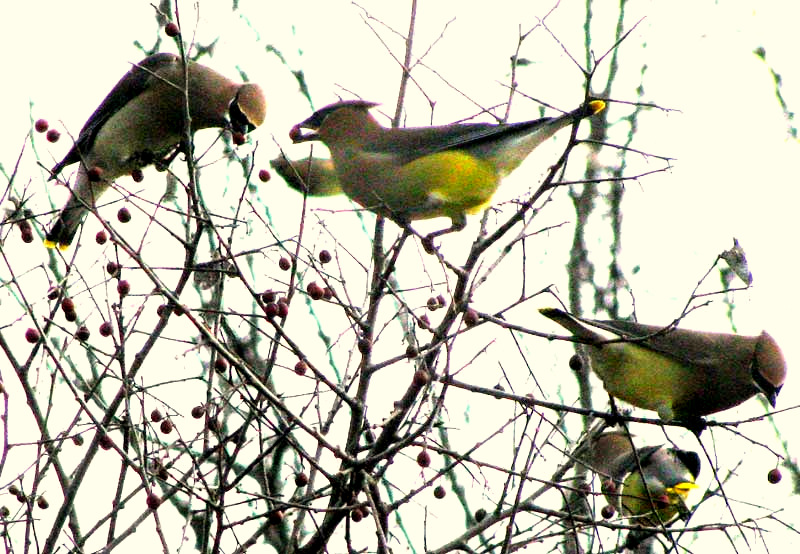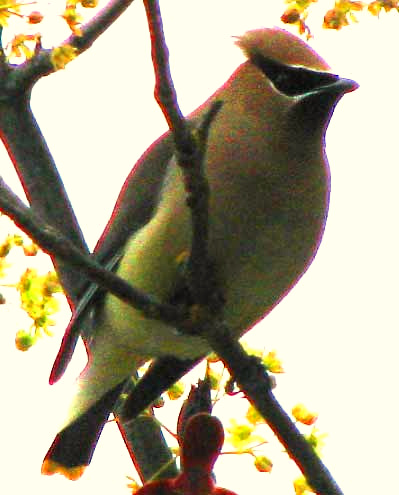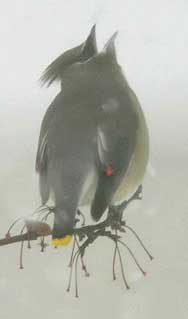Excerpts from Jim Conrad's
Naturalist Newsletter

from the January 27, 2013 Newsletter issued from the valley of the Dry Frio River in northern Uvalde County, southwestern Texas, on the southern border of the Edwards Plateau; elevation ~1750m (~5750 ft); N29.62°, W99.86°; USA
CEDAR WAXWINGS
Birds aren't migrating through here headed north yet, but still the spring feeling has begun to diffuse through the entire bird community, arousing a certain quickening of spirit, a finer alertness, a sharper vivacity. This is visible in their more intense sociality, greater curiosity, and playfulness. Of course I'm being anthropomorphic here, but we humans and birds are both animals with the same distant ancestors, so why shouldn't the spring feeling that gladdens my heart these days not also be gladdening the heart of birds around me?
I thought those thoughts this week when a flock of maybe 20 medium-sized birds flew over the cabin and descended into the top branches of a nearby leafless Netleaf Hackberry still heavily laden with its crop of sweet-fleshed, red fruits. As soon as the birds landed, instantly each one began stretching for red hackberries, testing this one and that one before plucking the one that was just right. That's them above.
Unmistakably, with those pointy head crests, black masks and dainty daubs of yellow, they're Cedar Waxwings. There's another slightly larger but very similar waxwing species, the Bohemian Waxwing, of northwestern North America, but that species never shows up this far south.
Thinking about how the waxwing flock's appearance set me to anthropomorphizing, I remembered how in earlier times great naturalists felt more at ease describing the behavior of other animals in terms of feelings shared with humans. For example, as a kid I collected most of the twenty-one volume series called Life Histories of Familiar North American Birds, published by the Smithsonian Institution between 1919 and 1968. Now that wonderful series ripe with anthropomorphic imagery is freely available online at http://www.birdsbybent.com.
In the 1950 edition describing the Cedar Waxwing, New Englander author Winsor Marrett Tyler wrote:
When we become well acquainted with the waxwing we look upon him as the perfect gentleman of the bird world. There is in him a refinement of deportment and dress; his voice is gentle and subdued; he is quiet and dignified in manner, sociable, never quarrelsome, and into one of his habits, that of sharing food with his companions, we may read, without too much stress of imagination, the quality of politeness, almost unselfishness, very rare, almost unheard of, in the animal kingdom. His plumage is delicate in coloring--soft, quiet browns, grays, and pale yellow--set off, like a carnation in our buttonhole, by a touch of red on the wing.
What a pleasure to see these birds so lustfully enjoying their hackberries, and for awhile to settle my mind in an intellectual ambiance which itself was like a carnation in the day's buttonhole.
from the April 19, 2009 Newsletter, issued from the Siskiyou Mountains west of Grants Pass, Oregon:
WAXWINGS
Friday I visited an ophthalmologist in town to check the progress of my eyes' cataracts and was surprised to encounter about a dozen Cedar Waxwings, BOMBYCILLA CEDRORUM, awaiting us, perching about ten feet high in flowering Norway Maples at the parking lot's edge. I'm used to seeing waxwings high in trees in the woods, not just ten feet up in a town parking lot. You can see one of these neat-looking birds, its colors bleached because of a very bright background, below:

All across the southern US Cedar Waxwings are only winter visitors. In much of the US Northeast and this part of the Pacific Northwest they're permanent residents, but most of their summer breeding ground lies in Canada.
During courtship the male and female may perch close to one another passing small objects back and forth, maybe a small fruit or a bug. Mating pairs sometimes rub their beaks together in a way that to human eyes looks a lot like an expression of affection. I've never seen a solitary Cedar Waxwing; they're always in small to large flocks.
According to an online etymology site the name "waxwing" derives from "... the tips of its feathers which look like red sealing-wax." The whole bird seems made of wax to me, crafted by a master artist creating a bird prettier than it really needs to be, and I guess that that's exactly the case after all.
from the February 1, 2004 Newsletter, issued from near Natchez, Mississippi:
CEDAR WAXWINGS DOING ODD THINGS
 Speaking of bird behavior, Cindy in northeastern Michigan sent me a wonderful picture she took of a Cedar Waxwing during a heavy snow. The bird is shown with its head thrown back and its beak wide open -- that's it at the right. When Cindy explained that it was catching snowflakes I replied that surely it was disgorging fruit pits, or seeds, after having a big meal of something like hackberry fruits. Often I've seen waxwings eat several such fruits, then fly to a nearby perch and as their crops removed the fruits' fleshy parts the birds would "cough up" the hard pits and let them fall onto the ground. However, Cindy replied that "they were definitely catching snow because some were 'pecking' at the air. No pits were spit."
Speaking of bird behavior, Cindy in northeastern Michigan sent me a wonderful picture she took of a Cedar Waxwing during a heavy snow. The bird is shown with its head thrown back and its beak wide open -- that's it at the right. When Cindy explained that it was catching snowflakes I replied that surely it was disgorging fruit pits, or seeds, after having a big meal of something like hackberry fruits. Often I've seen waxwings eat several such fruits, then fly to a nearby perch and as their crops removed the fruits' fleshy parts the birds would "cough up" the hard pits and let them fall onto the ground. However, Cindy replied that "they were definitely catching snow because some were 'pecking' at the air. No pits were spit."
Right after receiving that picture, Leona in Missouri wrote "I have been noticing rustlings in the dry oak leaves, rustlings when there is no wind, and close scrutiny discloses cedar waxwings tucking themselves into curled oak leaves. To keep warm? To make interesting noise? Who could guess. Last week when I was working in shirtsleeves and it was warm, I was surprised by a whole flock of them flying out of a brown-leafed oak. Now, (it was 4 degrees this morning and 20 degrees now) as I trudge back along the ridge with my bucket of sunflower seeds for the chickadees and nuthatches and titmice, downys and hairys and yellow bellied woodpeckers, I find oak trees with leaves that rustle and move and they are full of waxwings. So temperature does not seem to be the answer."
Around here regularly I spot high-flying waxwing flocks of 10-20 birds, issuing thin, high-pitched, quavering calls as they pass over. They fly in close formations and it's something to see how quickly each bird reacts to its neighbors' changes of course. The flock behaves like a single organism, a compact but diffuse unity perfectly conscious of itself.
from the December 9, 2001 Newsletter, issued from near Natchez, Mississippi:
CEDAR WAXWINGS AT DAWN
Tuesday morning as I prepared my campfire breakfast the season's first flock of Cedar Waxwings glided into the top of the big Pecan tree above my camp. Even without binoculars I knew they were waxwings because their flock was so compact and the flight of each bird was so perfectly synchronized with all the others. Flocks of American Robins and Starlings are much looser -- informal you could say. But these little Cedar Waxwings were like petite soldiers positioning themselves in the Pecan with a focused, almost mechanical seriousness.
"Mechanical" is also a word coming to mind when viewing the birds with binoculars. Each buff-colored, jauntily crested adult bird wears a narrow, black mask with a neat, white border. There's a dainty dab of red at each wingtip and a dapper yellow band across each tail's tip. The prim little bird looks as if it's been concocted by a skilled German craftsman -- almost too composed, contrived, sleek and elegant to be real.
Tuesday morning about 120 waxwings adorned my big Pecan's topmost branches. At first they perched silently and unmoving about a foot apart, each bird positioned so that dawn's low-slanting sunlight struck its broad chest. Waxwings, while small, possess rounded chests, and now in the morning sunlight 120 little chests made soft, oval glowings within the big Pecan's black reticulation of naked branches.
I admired by guests awhile, then returned to tending my fire. In twenty minutes I scanned them again with my binoculars and now it was a different scene, for every bird had broken into a frenzy of feather-preening and stretching. I was glad to see that they had made themselves at home.
Except for those observed during my recent backpacking trip in the Smokeys, the last Cedar Waxwings I had seen before Tuesday were those here late last spring when they were among the last winter residents to leave for their summer breeding grounds up North. At that time they were obviously loath to abandon our cherry trees. Early each morning they would warm themselves as the sun rose, quietly perched in the top of a certain tall Baldcypress near the orchard. Then suddenly the entire flock would descend into a cherry tree en masse, and every bird would energetically gorge itself. Sometimes it appeared that the cherry tree was waving its arms in amazement, such was the bustle within its boughs.
During summers Cedar Waxwings are found in Canada and much of the northern US, as far south as the higher elevations of the southern Appalachians. In the winter they shift southward, as far south as Panama, but their northern distribution still includes part of New England and Montana.